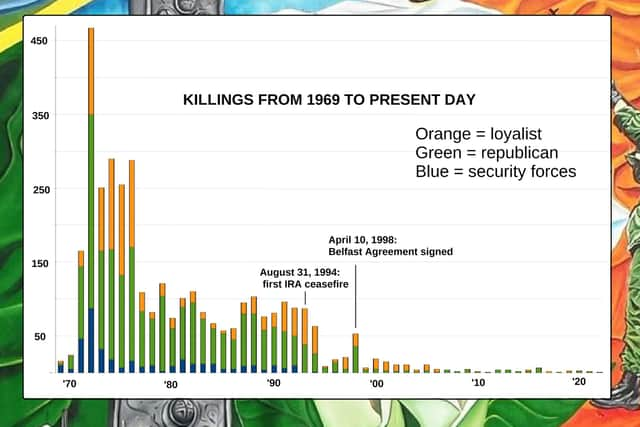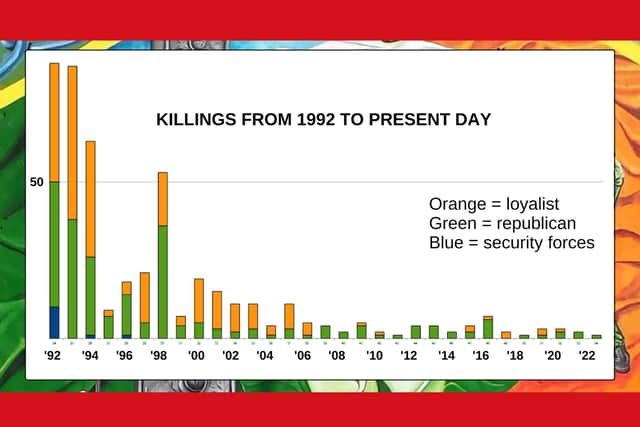Good Friday Agreement at 25: How death toll from Troubles violence changed in Northern Ireland after 1998 deal
and live on Freeview channel 276
There has been much fanfare around the anniversary, with US President Joe Biden and both Bill and Hillary Clinton set to jet into Belfast for events marking the milestone.
Here, the News Letter takes a look at one of the key factors behind the 1998 deal – the level of violence.
Advertisement
Hide AdAdvertisement
Hide AdThe deal is often credited with having “ended the Troubles” (as columnist Fintan O’Toole described it in a piece for the New York Times in 2017, for example).
But of course it did not bring about an absolute cessation of bloodshed; rather, it appears to have further suppressed violence which had been falling in a halting fashion ever since the peak in 1972.
An analysis of the data compiled by Ulster University’s CAIN (Conflict Archive on the Internet) indicates that well over 100 people have been murdered since the 1998 deal was signed, though it is hard to be precise about a number.
CAIN carries a list of 3,532 fatal Troubles victims spanning the main phase of the violence, from 1969 to 2002.
Advertisement
Hide AdAdvertisement
Hide AdBut of the 99 killings listed from 2002 onwards, a great proportion are described as possibly “non-conflict-related”.


The News Letter has used its own judgement in relation to these, and those deaths where paramilitary involvement is believed to have been a factor have been included in the charts in this story.
For example, whilst CAIN lists them as “uncertain if conflict-related”, we’ve included both the 2020 murder of Glenn Quinn in Carrickfergus (widely believed to be down to UDA men) and the killing of Ian Ogle in 2019 in east Belfast (reportedly by men linked to the UVF).
In summary, all this data – the CAIN figures from 1969 to 2002, followed by CAIN figures from 2002 onwards as interpreted by the News Letter – has been broken down in these charts into killings by loyalists (orange) and killings by republicans (green).
Advertisement
Hide AdAdvertisement
Hide AdIn broad-brush terms, some of the major milestones influencing the ebb and flow of annual fatalities shown in the charts here are the first IRA ceasefire of 1994, followed soon after by the Combined Loyalist Military Command ceasefire.


This ended in February 1996 with the Canary Wharf bombing, then the second IRA ceasefire of 1997 was followed by the Good Friday Agreement until eventually in 2005 the IRA was reported to have decommissioned all its weapons (or, at least, a large proportion of them).
The jump in fatalities in 1998 is down largely to the Omagh Bomb, a single attack four months after the signing of the Belfast Agreement, which killed 31 people.